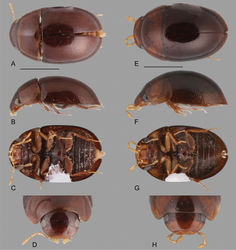Nanosaphes castaneus
| Notice: | This page is derived from the original publication listed below, whose author(s) should always be credited. Further contributors may edit and improve the content of this page and, consequently, need to be credited as well (see page history). Any assessment of factual correctness requires a careful review of the original article as well as of subsequent contributions.
If you are uncertain whether your planned contribution is correct or not, we suggest that you use the associated discussion page instead of editing the page directly. This page should be cited as follows (rationale):
Citation formats to copy and paste
BibTeX: @article{Girón2018ZooKeys, RIS/ Endnote: TY - JOUR Wikipedia/ Citizendium: <ref name="Girón2018ZooKeys">{{Citation See also the citation download page at the journal. |
Ordo: Coleoptera
Familia: Hydrophilidae
Genus: Nanosaphes
Name
Nanosaphes castaneus Girón & Short, 2018 sp. n. – Wikispecies link – ZooBank link – Pensoft Profile
Type material examined
Holotype (male): “BRAZIL: Pará: Rio Xingu/ Camp (52°22'W, 3°39'S)/ Altamira (ca 60km S.)/ 12 Oct 1986/ P. Spangler & O. Flint// Colln. #21, pond at 2nd/ palm grove on trail 1” (USNM). Paratypes (3): BRAZIL: Pará: Rio Xingu, Camp (52°22'W, 3°39'S)/ Altamira (ca 60km S.)/ 12 Oct 1986/ P. Spangler & O. Flint (1, USNM); same data as holotype (2, USNM, SEMC).
Differential diagnosis
Nanosaphes castaneus can be easily recognized by its smooth elytra (as opposed to rather coarsely punctate as in N. punctatus, compare Fig. 15A, B to Fig. 15E, F), and the uniform brown coloration along the body (as opposed to having yellow pronotum and brown elytra (as in N. hesperus and N. tricolor, compare Fig. 15A–D to Fig. 16).
Description
Body length 1.3–1.4 mm, width 0.8–0.9 mm. Body elongate oval, weakly convex, uniformly brown throughout (Fig. 15A, B). Dorsal surface shallowly punctate. Posterior elevation of mesoventrite weakly carinate. Pubescence of ventral surface scanty. Aedeagus (Fig. 18C) with basal piece 0.4-times the length of parameres; parameres longer than median lobe, with rounded apex; gonopore situated near apical third of median lobe.
Etymology
Named in reference to the uniform brown coloration along the body, with the Latin word castaneus meaning brown, of the color of chestnuts.
Distribution
Brazil (Pará). Only known from one locality. See Fig. 19.
Biology
In referencing Spangler’s original field notes, these specimens were collected in forested pond.
Original Description
- Girón, J; Short, A; 2018: Three new genera of acidocerine water scavenger beetles from tropical South America (Coleoptera, Hydrophilidae, Acidocerinae) ZooKeys, (768): 113-158. doi
Images
|



